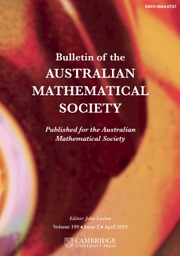No CrossRef data available.
Article contents
On the logarithmic derivatives of subordinate functions
Published online by Cambridge University Press: 17 April 2009
Abstract
Core share and HTML view are not available for this content. However, as you have access to this content, a full PDF is available via the ‘Save PDF’ action button.
Coefficient and integral mean bounds are obtained for functions subordinate to close-to-convex functions.
Information
- Type
- Research Article
- Information
- Copyright
- Copyright © Australian Mathematical Society 1987
References
[1]Baernstein, A., “Integral means, univalent functions and circular symmetrization”, Acta Math. 133 (1974), 129–162.CrossRefGoogle Scholar
[2]Baernstein, A. and Brown, J., “Integral means of derivatives of monotone slit mappings”, Comment. Math. Helv. 57 (1982), 331–348.CrossRefGoogle Scholar
[3]Brannan, D. and Clunie, J., Aspects of Contemporary Complex Analysis, (Academic Press, 1980).Google Scholar
[5]Elhosh, M.M., “On the logarithmic derivatives of close-to-convex functions”, Math. Japon. (to appear)Google Scholar
[6]Hallenbeck, D. and MacGregor, T., Linear Problems and Convexity Techniques in Geometric Function Theory, (Pitman Publ. Ltd., 1984).Google Scholar
[7]Hille, E., Ordinary differential equations in the complex domain, (John Wiley, 1976).Google Scholar
[8]Leung, Y., “Integral means of derivatives of some univalent functions”, Bull. London Math. Soc. 11 (1979, 289–284.CrossRefGoogle Scholar
[9]MacGregor, T., “Applications of extreme-point theory to univalent functions”, Michingan Math. J. 19 (1972), 361–376.Google Scholar
[10]Noor, K., “On the Hankel determinants of close-to-convex univalent functions”, Internat. J. Math. Math. Sci. 3 (1980), 477–481.CrossRefGoogle Scholar

